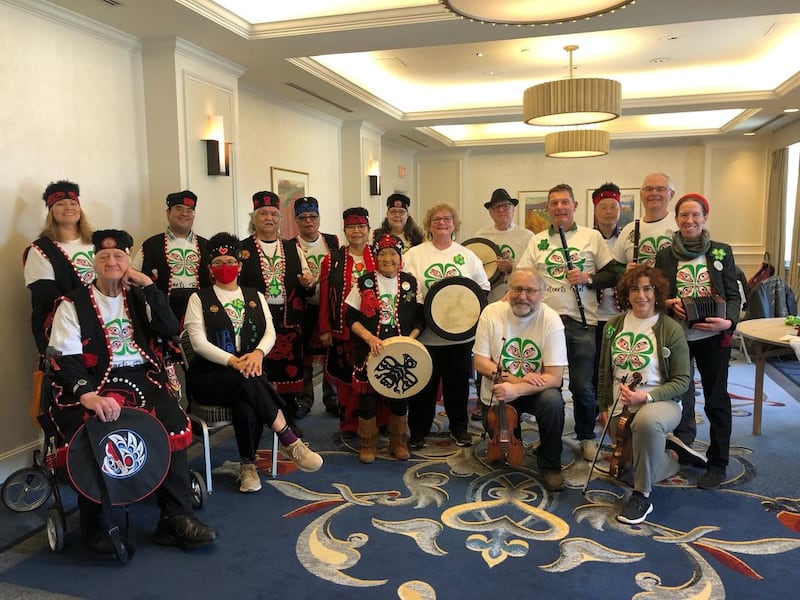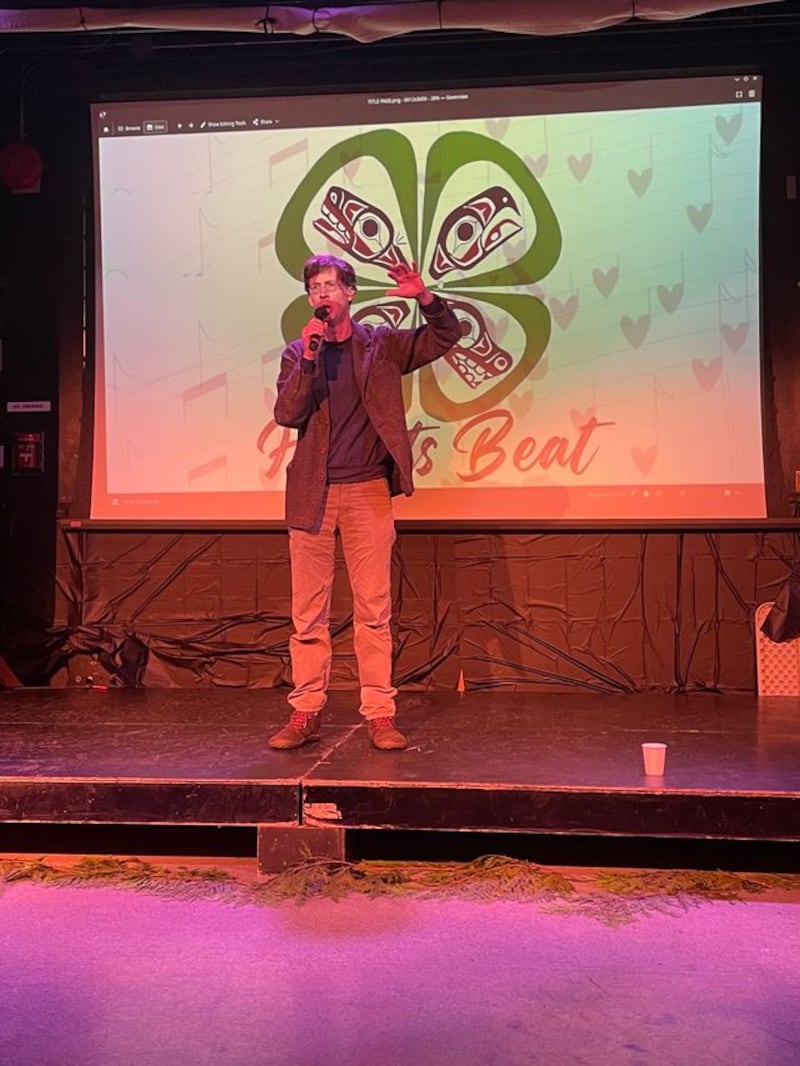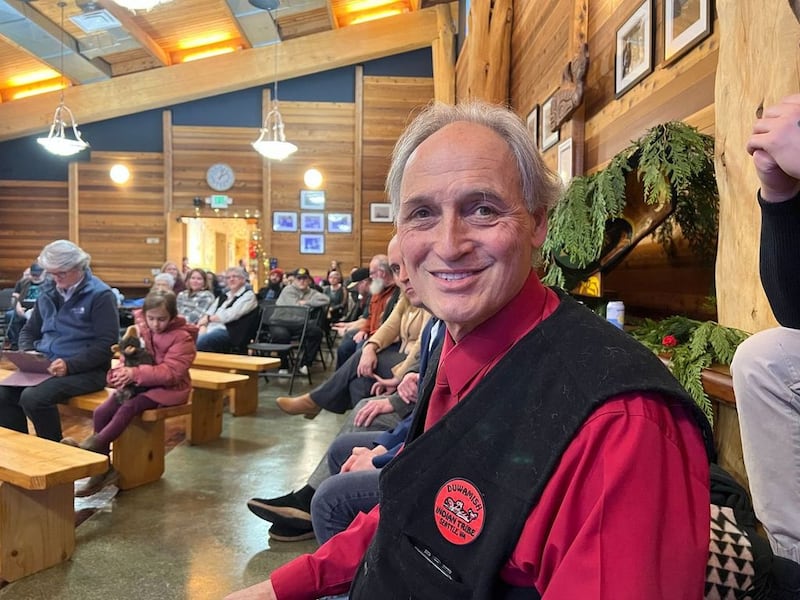Every city has its shadow side, and Vancouver’s is the Downtown Eastside, a once-elegant neighbourhood into which metropolitan authorities have deftly corralled the city’s homeless population, alongside its drug dealers, sex workers and vendors of stolen goods. Amidst the few surviving boutique shops and eateries, men and women lie sprawled on the pavement, many of whom are wiped out on fentanyl or crack cocaine. More people died of overdoses in British Columbia in May 2020 than died of Covid-19 over the entire year. The addicts come from all backgrounds and nationalities, but a significant proportion are First Nations, victims of the multigenerational trauma inflicted upon the native people of North America over centuries.
At the heart of the area is the former Carnegie Library, now a community centre providing food and various services to the homeless, the mentally ill and those in extreme poverty. Many of its users are indigenous, having become disconnected from their communities due to addiction, sexual abuse or mental health issues, or because of a variety of other reasons connected to intergenerational trauma and legacy issues caused by the notorious Indian residential schools. There can be a reluctance to return to their ancestral lands where they feel they may not be welcome, and also a reluctance to abandon their street “families”. It is here that a group of Irish and indigenous musicians meet to explore their shared traditions of drums, dance and song.
The musical collaboration arose when an elder of the Haida indigenous group, Isaac White, noticed the similarity between the tunes of some expat bodhrán players and his own native drum tradition at a gathering organised by the University of British Columbia’s (UBC) Learning Exchange, which works to connect the Downtown Eastside community with UBC students and faculty. It developed further when some of the city’s Irish trad musicians joined forces with lexwst’í:lem, a drumming group that had formed at the centre five years earlier to support indigenous music and ancestral teachings and – most importantly – to share and support the indigenous languages of its members, most of whom were First Nations people from across Western Canada. They now perform together under the shared name Hearts Beat, and they hope to come to Ireland once funding can be found – though the frail health of some members make planning precarious. The last two years have seen the death of two members of lexwst’í:lem.
This melding of Irish and indigenous musicians in a part of the city renowned for its high numbers of traumatised First Nations people is strangely appropriate, as the Irish had a role to play in the development of the trauma that is so apparent here. Firstly, through the behaviour of some unscrupulous and racist Irish settlers over the last 150 years, and by the discriminatory practices and policies of leaders, politicians and clergy of Irish descent in Canada over the centuries. But, most tangibly, in the formation of the Indian residential schools.
READ MORE
Linger a while in the company of Vancouver’s First Nations people and you’ll hear stories of the tragedy these “schools” inflicted upon their lives, or those of their parents and siblings. Many of them were forcibly separated from their families and sent away to be indoctrinated into white culture. They suffered punishment for any expression of their indigenous heritage and spiritual practices, or for speaking their languages. Their links to identity and community were irrevocably broken.
It was an Irishman, Nicholas Flood Davin from Kilfinane, Co Limerick, who oversaw these institutions. His 1879 Report on Industrial Schools for Indians and Half-Breeds, otherwise known as the Davin Report, was the catalyst for the federal government in Canada to develop an entire network of facilities whose purpose was to “sever children from the tribe” and “civilise” them. Many were run by priests and nuns from Ireland and elsewhere. Not until 1998 did the last of them close. In 2015 the Truth and Reconciliation Commission of Canada concluded that their assimilation policy amounted to cultural genocide.
It is hard to know what to do with such knowledge, although an Irish organisation, known as Landspeak, associated with the Ireland Canada University Foundation and the Centre for Canadian Studies in University College Dublin, consulted with indigenous Canadian elders and came up with the idea of arranging a public reading of the entire executive summary of the report of the Truth and Reconciliation Commission. They began reading on Canada’s National Day for Truth and Reconciliation, September 30th, 2021, and continued every Monday for three months. It was a simple act of acknowledgment and empathy; a recognition of our nation’s role in these dark centres of abuse and neglect, but also of the fact that we too have reports by commissions into child abuse and oppressive juvenile institutions sitting unread in our libraries and government offices here in Ireland.

The elders in Vancouver I talked to about Landspeak’s project were moved by the gesture. For many of them, the contents of the report have been too traumatising to read. They and members of their extended families showed courage by testifying to the commission, but many have not yet been able to share their experiences with their own families and friends – the sadness and shame is too great.
In recent years, thousands of undisclosed deaths that occurred within these schools are coming to light. Archaeologists uncovered 215 unmarked graves at an Indian residential school in Kamloops, British Columbia in 2021 – victims of overcrowding, malnutrition, poor sanitation and abuse. Weeks later, a further 751 unmarked graves were detected across from a residential school on the Cowessess reserve in Saskatchewan.
There can be no equivalence between the suffering Irish children endured in workhouses under British rule, or in Catholic care institutions, and the cultural genocide inflicted on First Nations people, but there are similarities. Institutionalised Irish children and First Nations children in Canada suffered physical, sexual, emotional and psychological abuse. The process of healing the trauma is beginning in both places.
I was invited to a full moon spirit dance on reserve land of the Squamish Nation, on the outskirts of Vancouver, in October. An elder of the Anishinaabe people led a group of indigenous and non-indigenous locals around the fire in a healing ceremony of drumming, singing and dance. Those gathered tried to use the few words of the Squamish language they had to reconnect with what has been lost. The language is classified as severely endangered, with no young people who can speak it fluently. Older Squamish residents were patiently trying to pass on to the children aspects of the ceremony that they could still remember – elements that hadn’t been forgotten during the missing decades of the residential schools.
For the elders, fire keepers, pipe carrier and ceremonial leaders of the community this work of healing and cultural remembering is paramount. They are dedicated to upholding the traditional law of nawt’samat (one heart, one mind, one soul), which can be summarised as “we are all related”. By this, they mean both the natural world and the human are one, such that many of the elders I met are involved with protests against the Trans Mountain pipeline which they say threatens numerous drinking water sources and ecosystems in the area, as well as the nearby Burrard Inlet and the orca whales that shelter there. Their campaigning work, and the bouts of imprisonment it can lead to, is a further burden on top of the challenges of healing communities and aiding the revival of their languages and cultures. Yet, as custodians of their ancestral lands and the animals that shelter there, they feel this too is a responsibility they cannot shirk.

This notion of the interconnection between all beings in the natural world also leads Squamish leaders to regularly invite homeless people from the Downtown Eastside out to the surrounding woodlands for bathing ceremonies and sweat lodges. Where aspects of old rituals have been lost or forgotten, they try to be guided by the blood memory of their ancestors. But they acknowledge that the old healing ceremonies struggle to cope with the devastation caused by the likes of fentanyl and crack cocaine.
The day after the full moon circle I was invited to a Sundance sweat lodge on land belonging to the Tsleil-Waututh Nation, which has also been subsumed by the city of Vancouver. Their land abuts the Burrard Inlet where the oil pipe is due to run. As scalding steam arose from the lava rocks in the centre of the lodge, I learnt of the severity of the trauma tribal members are suffering and the urgency to find workable solutions. At one time, the Tsleil-Waututh Nation consisted of thousands of people, but that dropped to just 13 surviving members. It is now back at around 600 people, many of whom are dealing directly or indirectly with the psychological and sociological legacy of the trauma endured in the residential schools, where children were raped, murdered and starved. All of them have family or friends who are caught in addiction in the Downtown Eastside, and the traditional healing modalities of sweat lodges and vision quests are not always enough to confront such profound intergenerational trauma.
Maintaining or reviving traditional tribal languages is recognised by many of the cultural elders I met as a key way of connecting people to their heritage and their place in the world. Healing and wisdom is often encoded within the old language. The Musqueam Indian Band is the third major indigenous nation whose land has been subsumed by Vancouver. Their website offers a comprehensive cultural teaching kit, with pronunciations and insights into the Musqueam language, hən̓q̓əmin̓əm̓. The language is also taught at the University of British Columbia, which now occupies former Musqueam hunting grounds.
All three indigenous nations of Vancouver face the extinction of their language. There are only a few dozen native speakers left in the Squamish Nation, while the Tsleil-Waututh Nation has about 40 fluent speakers of Hunq’eme’nem, and 80 conversational speakers. More people are now beginning to study it, and the nation’s 35 children are all learning their mother tongue. The hope is to raise a generation of first-language speakers, through language immersion camps, innovative techniques such as “hunting” for words, as well as more conventional classes. Such programmes require funding, which is where Ireland and settlers to Turtle Island (or North America, as the settlers called it) in general may have a role.
Some Irish-Americans across the border in Seattle have teamed up with the local Duwamish Tribe there to establish the Real Rent Duwamish initiative, in which people agree to pay a token monthly rent in acknowledgment of the fact that the land and resources they depend on were stolen from previous inhabitants. Tribal chair Cecile Hansen has commented that if each citizen of Seattle donated one dollar the revival of Duwamish culture and the vitality of the Duwamish Tribe could be secured.

I had lunch overlooking the Puget Sound with Ken Workman, a direct descendent of the last Chief Seattle, and heard how he had learnt fluent Lushootseed by going to classes, listening to old recordings and reconnecting with the places that were most important to his ancestors. Having retired from a career at Boeing, Workman had the time and resources to acquire these skills, but for others it seems that Irish-speaking organisations could have a part to play.
There are more than 70 distinct indigenous languages in Canada and hundreds of mutually unintelligible dialects, according to government statistics, and more again across the border in Washington state. In total, they are not getting even a tiny fraction of the money an Ghaeilge gets from the EU and the Irish Government. We are an affluent, independent, sovereign nation with nothing to stop us learning our language ourselves, if we really want to. If we truly profess to being supporters of indigenous languages, would it not make sense to direct even a fraction of the millions we receive to languages that really are in imminent danger of falling extinct?
Hearts Beat video: https://youtu.be/BdVivgiTErs?si=h8T5Xk4rapA8Cd8k
- Sign up for push alerts and have the best news, analysis and comment delivered directly to your phone
- Find The Irish Times on WhatsApp and stay up to date
- Listen to our Inside Politics podcast for the best political chat and analysis










